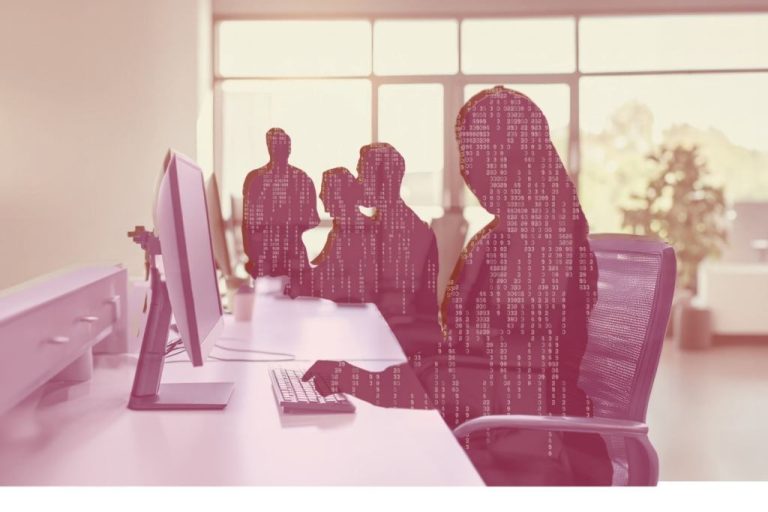Entrepreneur
Key Takeaways
- AI is accelerating white-collar job reductions, especially in data-driven roles like software development, customer support and finance.
- AI is likely both a cause and accelerator of job losses. Companies use AI not only to automate tasks but also as a justification for streamlining operations and reducing their workforce.
- Leaders should identify roles where AI boosts productivity (not just cost savings), train employees on AI systems and redefine roles around creativity, strategy and areas AI can’t address.
Major business publications and leading news sources are reporting a wave of white collar job reductions. Is artificial intelligence the primary reason behind this trend? Many experts believe it is.
Not long ago, business journalists and others speculated on the extent to which AI would replace or affect jobs. It could be described as the “calm before the algorithm.” Now, it is undeniable that algorithms are having a significant impact.
A recent article in The Wall Street Journal specifically addressed AI’s influence on the white-collar job market. Amazon and United Parcel Service (UPS) both announced plans to reduce approximately 14,000 positions each. Retail giant Target is reducing its workforce by 1,800 employees. Molson Coors and General Motors will issue lots of pink slips before year’s end.
Are we experiencing the first white-collar displacement of the 21st century? It appears so. This leaves many entrepreneurs wondering how many of their key employees may be replaced by AI shortly.
Related: Is AI Taking Your Job This Year? Staggering Stats Show How the Technology Is Reshaping the Workforce.
Does AI affect blue or white collar jobs most?
To answer this question, I consulted leading search engines to determine which types of jobs will be most affected by AI. Interestingly, the top search response was answered by Mr. AI himself, or Ms. AI herself, if you prefer.
Positions like data entry, customer service and software engineering have seen job reductions due to AI advancements. It’s frustrating for anyone seeking assistance with a product or service when they encounter AI chatbots instead of a real person to address their questions or issues. However, the chatbot doesn’t eat into a company’s healthcare costs, show up late or demand a six-figure salary.
Think of customer service AI transitions in these terms: A call center that used to employ 500 CSRs now exists with 50 AI specialists. Old skills are eroding, and new roles that require more technical expertise are growing, albeit at a slower rate.
On the other hand, typical blue-collar roles in construction, healthcare and hospitality are experiencing shortages because of a decrease in job applications. Although there is high demand for employees with advanced AI skills, other factors, such as the current political climate, economic conditions and the supply of workers, also influence the job market.
It’s clear that white-collar workers have more reason to fear an AI takeover than their blue-collar counterparts. While exercising in the evening, I often pass a commercial roofing company and notice that the roofers themselves are not in immediate danger of being replaced by AI. However, the employees who design roofing projects may need to update their resumes. You can think of AI’s impact on job replacement in these terms:
-
Data-driven jobs are being hit hardest by AI (i.e., software development, finance, customer support)
-
Data-poor jobs (where human interaction is important) are remaining steady or increasing (i.e., healthcare, construction, education, public safety)
Is AI or efficiency the real job culprit?
One question I’ve recently asked myself is whether AI is the cause or the accelerator of job losses. The answer is likely both.
Practically every large corporation utilizes AI in various capacities. Large language models, such as ChatGPT, learn from processing vast amounts of data. Assuming this data is accurate, it’s clear how positions in trading and coding could be negatively affected.
Moreover, companies might use AI as one of several justifications for reducing their workforce. This is certainly an intriguing time in corporate America. Managers desire sustained growth but want to avoid increasing headcount, expecting AI to help achieve this goal.
For instance, Goldman Sachs recently issued an internal memo stating that it intends to restrain headcount in the coming year. Similarly, Walmart, a company that typically relies on expanding its stores and workforce for growth, announced that its headcount would remain flat even with projected growth. Just as self-checkout terminals have reduced the number of cashiers on each shift, AI is also replacing some white-collar corporate jobs.
Next is the “bureaucracy factor.” Downsizing bloated departments results in fewer meetings and shorter breakroom conversations, ultimately reducing the number of employees affected by the Monday morning and Friday afternoon slumps. Additionally, the decision on whether to require employees to work on site or remotely becomes less relevant. AI can work from any location, allowing companies to save hours on labor without the need for an overtime budget.
AI is undoubtedly impacting the corporate workforce. C-suite executives can use various reasons to explain these reductions to their remaining employees. So, how will AI affect your employee headcount?
Related: The CEO of the Biggest Employer in the Country Says AI Will Transform ‘Literally Every Job’ at His Company (and Yours, Too)
Is AI impacting my industry?
Fortunately for our company, AI isn’t replacing our employees anytime soon. As I mentioned in previous articles, our team takes pride in direct customer contact. That’s why a real person answers when the phone rings.
Now, what about our direct line employees, the individuals who transcribe client audio and video files? Conventional wisdom suggests that software transcription programs are faster and more efficient, potentially replacing my human transcriptionists.
Like most companies, our website contains a FAQ (Frequently Asked Questions) page with comprehensive information about our transcription services. In fact, our second FAQ reads, “Why are humans considered more reliable than AI and software?” The answer is straightforward: It’s all about the error rate.
Our response to the question sums up the issue: “Humans understand context and can pinpoint a voice when multiple people are speaking over one another. AI and software often struggle with determining who is speaking and can make incorrect guesses about homonyms and words that sound alike.”
Since I’m not a fan of AI-generated chatbots, I don’t plan to replace my exceptional office staff. Until AI transcription programs make significant advancements, my U.S.-based human transcriptionists will continue to produce the most reliable transcripts possible.
What to expect from AI in 2026
As of now, many companies are still in the “experimental” phase of AI usage. However, by 2026, AI is expected to enter the mainstream for both existing and new users.
According to a report from Deloitte, three AI trends are expected for 2026:
-
Agentic AI autonomous systems that can adapt to changing environments
-
Physical AI intelligent machines that can interact with their environments
-
Sovereign AI ensures that data and model weights remain within established boundaries
With the abundance of AI terminology, it can be a challenge to keep track of everything. Here’s a brief overview of these three new concepts:
Agentic AI
Intelligent systems that can quickly adapt to changing environments, make complex decisions and collaborate with humans comprises agentic AI. This process will enable companies or departments to automate both repetitive and multistep processes.
For instance, AI agents in customer service can triage and resolve support tickets, allowing human employees to focus on more complex cases. In supply chains, agentic AI can optimize inventory, logistics and procurement in real time.
Financial services firms like Goldman Sachs will also benefit from this technology through automated portfolio management, fraud detection and regulatory compliance — all without human intervention. Because compliance is critical, AI models must be accurate to avoid significant regulatory and legal issues. As a result, agentic AI will transition from pilot projects to broader adoption.
Physical AI
Embedding AI into the physical world can include everything from warehouse robots to smart medical devices. Physical AI is designed to unleash new efficiencies and improve safety in areas where such automation was limited by cost or complexity.
Imagine robots and AI-powered control systems designed to reduce defects and downtime. A logistics department might utilize autonomous vehicles and drones to streamline deliveries and warehouse operations. Companies like Amazon and Walmart are already effectively employing physical AI, and this trend is expected to grow by 2026.
Sovereign AI
As data privacy regulations tighten globally due to increased AI implementation, sovereign AI will help ensure that model weights, data and computing resources remain within specific regional or national boundaries.
For example, our company handles a large volume of healthcare documentation, so we must be HIPAA compliant to protect patient privacy. Sovereign AI allows for the processing and storage of patient data locally, in compliance with privacy laws.
Financial data also requires strict protection. While our primary focus has been on AI use in the private sector, governments will also employ AI to enhance transparency and local control. Unsurprisingly, public employee unions are raising concerns about the potential for government AI usage to reduce their workforce.
Related: Many Employees Fear Being Replaced by AI — Here’s How to Integrate It Into Your Business Without Scaring Them.
How will AI impact your key employees?
While I am open to incorporating AI into our business, I do not foresee any loss of headcount due to AI implementation. Here are a few AI recommendations to consider as we approach the end of the year.
Instead of merely reacting to changes in AI, let’s take a proactive approach and present a three-step strategy to key managers:
-
Identify roles where AI improves productivity, not just cost savings
-
Train selected employees on AI systems and workflow strategies
-
Redefine roles around human creativity, strategy and areas AI cannot address
Remember to leverage AI to your advantage and embrace new technology. Simultaneously, encourage key employees to learn or transition into new skill sets.
Read the full article here









